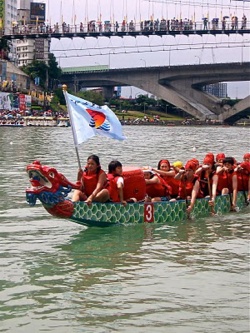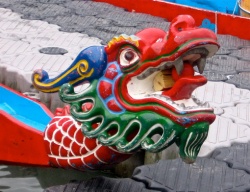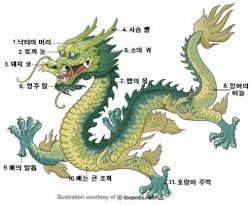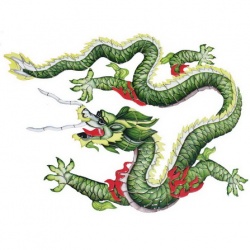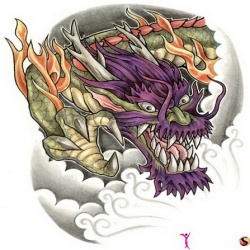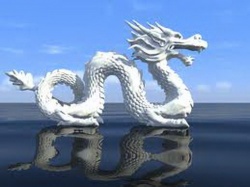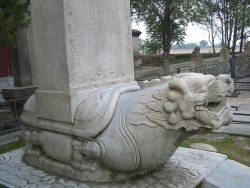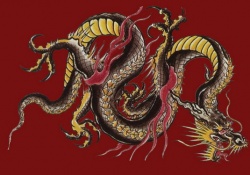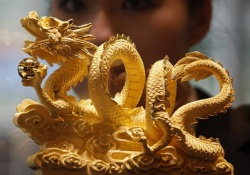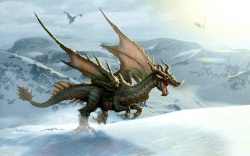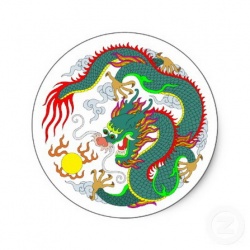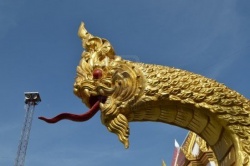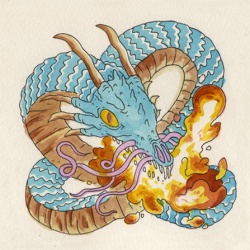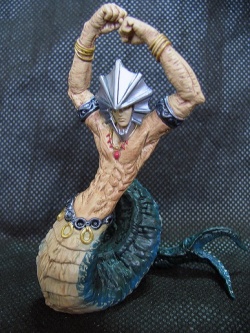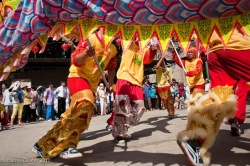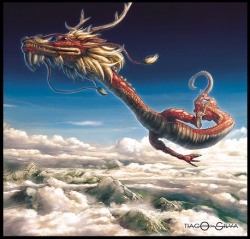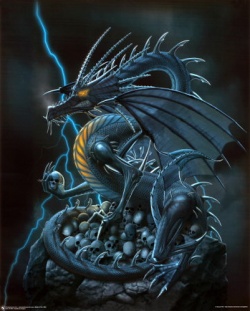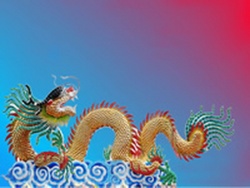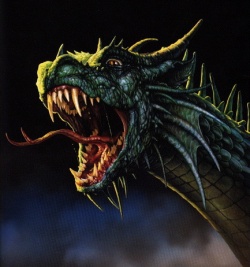Dragon boat
<poem> A dragon boat (also dragonboat) is a human-powered watercraft made in the Pearl River Delta region of China's southern Guangdong Province out of teak wood to various designs and sizes. In other parts of China different woods are used to build these traditional watercraft. It is one of a family of Traditional Paddled Long Boats found throughout Asia, Africa, and the Pacific Islands. Dragonboats are the basis of the team paddling sport of dragon boat racing an amateur watersport which has its roots in an ancient folk ritual of contending villagers held over the past 2000 years throughout southern China. While 'competition' has taken place annually for more than 20 centuries as part of religious ceremonies and folk customs, dragon boat racing has emerged in modern times as an international sport, beginning in Hong Kong in 1976. But the history of dragon boats in competition reaches as far back as the same era as the original games of Olympia in ancient Greece. Both dragon boat racing and the ancient Olympiad included aspects of religious observances and community celebrations along with competition.
For competition events, dragon boats are generally rigged with decorative Chinese dragon heads and tails. At other times such as training the decorative regalia is usually removed, although the drum often remains aboard for practice by drummers.
Dragon boat races are traditionally held as part of the annual Duanwu Festival or Duen Ng observance in China. 19th-century European observers of the racing ritual, not understanding the significance of Duanwu, referred to the spectacle as a "dragon boat festival". This is the term that has become known in the West.
Dragon boat racing, like Duanwu, is observed and celebrated in many areas of east Asia with significant populations of ethnic Chinese living there e.g. Singapore, Malaysia, Riau Islands and Greater China. The date is referred to as the "double fifth" since Duanwu is reckoned as the fifth day of the fifth lunar calendar, which often falls on the Gregorian calendar month of June, but also, rarely, in May or July. This is because Duanwu is reckoned annually in accordance with the traditional calendar system of China, which is a combination of solar and lunar cycles, unlike the solar-based Gregorian calendar system. Christian Easter is another example of lunar-based calendar and date reckoning.
In December 2007, the central government of the People's Republic of China added Duanwu, along with Qingming and Mid-Autumn festivals to the schedule of national holidays observed in the People's Republic of China, such is the importance of dragonboating in China today.
History
Similar to outrigger canoe (va'a) racing but unlike competitive rowing and canoe racing, dragon boating has a rich fabric of ancient ceremonial, ritualistic and religious traditions. In other words, the modern competitive aspect is but one small part of this complex of water craftsmanship. The use of dragon boats for racing and dragons are believed by scholars, sinologists and anthropologists - for example George Worcester, authoritative author of 'Junks and Sampans of the Yangtze River' - to have originated in southern central China more than 2,500 years ago, in Dongting Lake and along the banks of such iconic rivers as the Chang Jiang, also known as Yangtze (that is, during the same era when the games of ancient Greece were being established at Olympia). Dragon boat racing as the basis for annual water rituals and festival celebrations, and for the traditional veneration of the Asian dragon water deity, has been practiced continuously since this period. The celebration is an important part of ancient agricultural Chinese society, celebrating the summer rice planting. Dragon boat racing activity historically was situated in the Chinese sub-continent's southern-central "rice bowl": where there were rice paddies, so were there dragon boats. dragon boating is mostly celebrated in china
Of the twelve animals which make up the traditional Chinese zodiac, only the Dragon is a mythical creature. All the rest are non-mythical (Dog, Rat, Tiger, Horse, Snake, Rabbit, Rooster, Monkey, Goat, Ox, Pig), yet all twelve of these zodiac creatures were well known to members of ancient Chinese agrarian communities. In China, dragons are traditionally believed to be the rulers of rivers, lakes and seas (so water) and to dominate the clouds, mists and rains which are of heaven. There are earth dragons, mountain dragons and sky or celestial dragons (Tian Long) in Chinese tradition. Mythical dragons and serpents are also found widely in many cultures around the world.
It is believed sacrifices through drowning may have been involved in the earliest boat racing rituals. During these ancient times, violent clashes between the crew members of the competing boats involved throwing stones and striking each other with bamboo stalks. Originally, paddlers or even an entire team falling into the water could receive no assistance from the onlookers as their misfortune was considered to be the will of the Dragon Deity which could not be interfered with. Those boaters who drowned were thought to have been sacrificed. That Qu Yuan sacrificed himself in protest through drowning speaks to this early notion. Furthermore, when rice seedlings are first planted, they are 'drowned' in rice paddies and eventually transplanted to be harvested later.
Dragon boat racing traditionally coincides with the 5th day of the 5th Chinese lunar month (varying from late May to June on the modern Gregorian Calendar). The Summer Solstice occurs around 21 June and is the reason why Chinese refer to their festival as "Duan Wu" or "Duen Ng". Both the sun and the dragon are considered to be male. (The moon and the mythical phoenix are considered to be female.) The sun and the dragon are at their most potent during this time of the year, so cause for observing this through ritual celebrations such as dragon boat racing. It is also the time of farming year when rice seedlings must be transplanted in their paddy fields, for wet rice cultivation to take place. Wu or Ng refers to the sun at its highest position in the sky during the day, the meridian of 'high noon'. Duan or Duen refers to upright or directly overhead. So Duan Wu is an ancient reference to the maximum position of the sun in the northern hemisphere, the longest day of the year or summer solstice.
This hot season is also associated with pestilence and disease, so is considered as a period of evil due to the high summer temperatures which can lead to rot and putrification in primitive societies lacking modern refrigeration and sanitation facilities. One custom involves cutting shapes of the five poisonous or venomous animals out of red paper, so as to ward off these evils. The paper snakes, centipedes, scorpions, lizards and toads - those that supposedly lured "evil spirits" - where sometimes placed in the mouths of the carved wooden dragons.
Venerating the dragon deity was meant to avert misfortune and calamity and encourage rainfall which is needed for the fertility of the crops and thus for the prosperity of an agrarian way of life. Celestial dragons were the controllers of the rain, the Monsoon winds and the clouds. The Emperor was "The Dragon" or the "Son of Heaven", and Chinese people refer to themselves as "dragons" because of its spirit of strength and vitality. Unlike the dragons in European mythology which are considered to be evil and demonic, Asian dragons are regarded as wholesome and beneficent, and thus worthy of veneration, not slaying. But if rainfall is insufficient drought and famine can result. Dragon veneration in China seems to be associated with annually ensuring life giving water and bountiful rice harvests in south central China.
Another ritual called Awakening of the Dragon involves a Daoist priest dotting the bulging eyes of the carved dragon head attached to the boat, in the sense of ending its slumber and re-energising its spirit or qi (pronounced: chee). At festivals today, a VIP can be invited to step forward to touch the eyes on a dragon boat head with a brush dipped in red paint made of the blood of a chicken in order to reanimate the creature's bold spirit for hearty racing.
Qu Yuan
The other main legend concerns the poignant saga of a Chinese court official named Qu Yuan, also phoneticised Ch'u Yuen. It is said that he lived in the pre-imperial Warring States period (475-221 BC). During this time the area today known as central China was divided into seven main states or kingdoms battling among themselves for supremacy with unprecedented heights of military intrigue. This was at the conclusion of the Zhou (Chou) Dynasty, which is regarded as China's classical age during which Confucius (Kongfuzi) lived. Also, the author Sun Tzu is said to have written his famous classic on military strategy The Art of War during this era.
Qu Yuan is popularly regarded as a minister in one of the Warring State governments, the southern state of Chu (present day Hunan and Hubei provinces), a champion of political loyalty and integrity, and eager to maintain the Chu state's autonomy and hegemony. Formerly, it was believed that the Chu monarch fell under the influence of other corrupt, jealous ministers who slandered Qu Yuan as 'a sting in flesh', and therefore the fooled king banished Qu, his most loyal counsellor.
In Qu's exile, so goes the legend, he supposedly produced some of the greatest early poetry in Chinese literature expressing his fervent love for his state and his deepest concern for its future. The collection of odes are known as the Chuci or "Songs of the South (Chu)". His most well known verses are the rhapsodic Li Sao or "Lament" and the fantastic Tien Wen or "Heavenly Questions".
In the year 278 B.C., upon learning of the upcoming devastation of his state from invasion by a neighbouring Warring State (Qin in particular), Qu is said to have waded into the Miluo river which drains into Dongting Hu (lake) in today's Hunan Province—near the provincial capital city of Changsha and south of the city of Yueyang on Donting Hu, site of the first IDBF World Dragon Boat Championship in 1996—holding a great rock in order to commit ritual suicide as a form of protest against the corruption of the era. The Qin or Chin kingdom eventually conquered all of the other states including Chu and unified them into the first Chinese empire. The word China derives from this first dynasty of empire, the Qin (or Chin) Dynasty, under imperialist unifier Qin Shi Huang.
The common people, upon learning of his suicide, rushed out on the water in their fishing boats to the middle of the river and tried desperatedly to save Qu Yuan. They beat drums and splashed the water with their paddles in order to keep the fish and evil spirits from his body. Later on, they scattered rice into the water to prevent him from suffering hunger. Another belief is that the people scattered rice to feed the fish, in order to prevent the fishes from devouring the poet's body.
However, late one night, the spirit of Qu Yuan appeared before his friends (that is, he resurrected from the dead) and told them that the rice meant for him was being intercepted by a huge river dragon. He asked his friends to wrap their rice into three-cornered silk packages to ward off the dragon. This has been a traditional food ever since known as zongzi or sticky rice wrapped in leaves, although they are wrapped in leaves instead of silk. In commemoration of Qu Yuan it is said, people hold dragon boat races annually on the day of his death.
Today, dragon boat festivals continue to be celebrated around the world with dragon boat racing, although such events are still culturally associated with the traditional Chinese Duen Ng Festival in Hong Kong (Cantonese Chinese dialect) or Duan Wu festival in south central mainland China (Mandarin Chinese dialect). Taiwanese finish line flags and flag pullers
A Song Dynasty (circa 1000 AD) silk painting depicts an imperial dragon boat competition that took place then in the ancient Chinese capital of Kaifeng. It shows dragon boats, referee boats, marked racing lanes, spectators, streamers, flags and banners and race officials. Since there were no "photofinish cameras" at the time, close races were adjudicated by a panel of judges who observed which crew was the first to pull, grasp or grab a flag that rested on a buoy positioned at the finish line for each racing lane. There was nothing to "catch" since nothing was "thrown".
Floor-to-ceiling high photographic enlargements of Song Dynasty paintings of dragonboat races are displayed on the walls of the "Golden Ocean" Chinese seafood restaurant in Vancouver Canada, for example (in the Kerrisdale district on 49th Avenue east of West Boulevard). These historical Song illustrations inspired some dragon boat race organizers in Taipei Taiwan to replicate flag pulling finish line markers in their annual races, the only place in Asia where this particular, and peculiar form of racing apparatus can be found.
This competition arrangement gave rise to an additional crew position, that of the flag puller. The flag puller rides aboard near the decorated dragon head, out of the way of the drummer. As the boat nears the finish line flag float, the flag puller extends his or her arm outboard to grab the flag from the lane float to signal attainment of the finish line as the boat whizzes by. The steerer has to accurately steer the boat within arms reach of the flag mount. Electronic devices are sometimes used to accurately capture times. The flag puller must not miss pulling the flag, otherwise the boat's finish is disqualified. The incongruous English term "flag catcher" seems to have been perpetrated and perpetuated by American Dragon Boat Association racers based in the state of Iowa, since the Chinese character doesn't translate to "catcher" but rather "puller" or "grabber".
Crew
The standard crew complement of a contemporary dragon boat is typically 22, comprising 20 paddlers in pairs facing toward the bow of the boat, 1 drummer or caller at the bow facing toward the paddlers, and 1 sweep (a steerer) at the rear of the boat. Dragon boats however vary in length and the crew size will change accordingly, from small dragon boats with 10 paddlers up to the traditional boats which have upwards of 50 paddlers, plus drummer and sweep. In the area around the Tian He District of Guangzhou, Guangdong,China, the paddlers will increase to 80 or more.
Drummer
The pulsation of the drum beats produced by the drummer maybe considered the "heartbeat" of the dragon boat. The drummer leads the paddlers throughout a race using the rhythmic drum beat to indicate the frequency and synchronicity of all the paddlers' strokes (that is, the cadence, picking up or accelerating the pace, slowing the rate, etc.) The drummer may issue commands to the crew through a combination of hand signals and voice calls, and also generally exhorts the crew to perform at their peak. A drummer is mandatory during racing events, but if he or she is not present during training, it is typical for the sweep to direct the crew. The drummer's role is both tactical and ceremonial, unlike that of a coxswain of a rowing shell such as an 'eight'. Whereas paddlers face forward and the drummer backwards, it is reversed in rowing shells where all the rowers face backwards with the coxswain the only one in the boat facing forward and able to view the straight ahead course of the craft as it makes its way down the regatta course lane towards the finish line.
Good drummers should be able to synchronise the drumming cadence with the strokes of the leading pair of paddlers, rather than the other way around. As a tail wind, head wind or cross wind, may affect the amount of power needed to move the boat at hull speed throughout a race, a caller should also be aware of the relative position of the dragon boat to other boats, and to the finish line, in order to correctly issue commands to the crew as to when to best surge ahead, when to hold steady and when to peak for the finish. An expert level caller will be able to gauge the power of the boat and the paddlers through the sensation of acceleration, deceleration, and inefficiencies which are transmitted through the hull (i.e. they will physically feel the boat action through their feet and gluteus maximus muscles).
Traditional dragonboats with 40 to 50 paddlers are so long that the drum is positioned amidships (in the middle of the boat) so that all paddlers can hear it amidst the noise of heated competition. However, for the smaller dragon boats of 20 paddlers which are most often used in competitive sporting events, the drum is located just aft of the dragon headed prow.
Some crews may also feature a gong striker who strikes a ceremonial gong mounted aboard the dragon boat. A gong striker may sometimes be used as an alternative to a drummer.
Paddlers
The paddlers sit facing forwards (unlike aft-facing seated rowers), and use a specific type of paddle which (unlike a rowing oar or sculling scull) is not rigged to the racing watercraft in any way. Therefore, Dragon boaters are paddlers not rowers or oarsmen/women. They paddle in a general canoe style since canoes dragon boats, proa's and rafts are all distinctly differing paddle craft all paddled similarly variations exist due to the size and seating position in the boat (Note that the sweep is not a helmsman or 'coxswain', which are British-based naval and competitive rowing terms (coxswain is also a Canadian War Canoe racing term) for the person in charge of the boat. In dragon boating, the drummer takes charge, however if there is only a sweep and no drummer, the sweep generally takes charge.)
The paddle now accepted by the world racing federation has a standardised, fixed blade surface area and distinctive shape derived from the paddle shapes characteristic of the Zhu Jiang (Pearl River) delta region of Guangdong Province, China, close to where Hong Kong is situated. The PS202 pattern blade has straight flared edges and circular arced shoulders based geometrically on an equilateral triangle shape positioned between the blade face and the neck of the shaft.
The leading pair of paddlers, called "pacers," "strokes" or "timers," set the pace for the team. It is critical that all paddlers are synchronised. Each paddler should synchronise with the stroke or pacer on the opposite side of the boat, that is, if you paddle starboard side (right) you would take your timing from the port side (left) stroke. The direction of the dragon boat is set by the sweep, rather than by the paddlers while actually racing, however for docking and other manoeuvres, individual paddlers may be asked to paddle (while others either stop the boat or rest) according to the commands given by the drummer or sweep. The two lead strokes are responsible for synchronising their strokes together with one another.
There are several components to a dragon boat stroke cycle:
1. The "reach and catch" begins the cycle and is preceded by a set-up torso rotation; the blade angle of attack (angle of entry relative to the water plane) appears from the side to be raked aft, however this is an optical illusion since the boat is advancing. Inserting the blade perpendicular to the water amounts to ineffective "lily dipping" or "tea-bagging" wherein the blade moves backwards in the water past the paddler's hips simply because the boat is moving forward.
A common misunderstanding is the "upper arm drive". In dragon boating the top arm's main role is to keep the paddle in place and not lose pressure by wobbling or go in a slant. Some think that the "push" allows an explosive de-rotation, but in fact it is simply an illusion that an otherwise under-used top arm is being useful. Pushing the top hand down changes the paddle entry angle to neutral in most applications of the stroke; the only plausible point where the top arm can participate in the stroke is perhaps after the bottom arm has initiated the pull and the paddle face is at or past the paddler's knee, to add a "kick" towards the back of the stroke. Overusage of the top arm to drive down will also result in excessive up-down movement on the boat and disturb its glide. A possible source of this misunderstanding is from kayaking sports, where the paddle design allows for both sides of the body to be integral to the stroke; the forward rotation of the "top arm" allows for both a return on one side and de-rotation of the other. It is also worth noting that in kayaking, given the paddler's position on the entry of the blade (the shaft is across the kayak), it is possible to have the top arm participate without having excessive downward force.
There is significant difference between the downward force of a paddler's weight being transferred from body to paddle, and the force of the paddler's top arm prematurely de-rotating the paddler's body.
2. The powerful "pull" stage sustains the forward momentum of the boat; the paddle is pulled backwards.
3. The "release" in which the blade is instantaneously drawn (skywards) while it is even with the hips of the paddler; because the boat is moving forward, the optical illusion from outside the boat makes the blade seem like it is being withdrawn at an angle that is raked forward. The release coincides with the set up rotation or recoil of the torso.
4. The "recovery" is the final stage of the stroke and consists of the rotation of the torso with the forward repositioning of the blade thrust forward into the optimal catch. By decreasing the time it takes between the release and the catch, the percentage of time in the cycle when the boat is decelerating (due to drag friction among other slowing forces) is minimised; therefore it is possible to perform a greater number of catches and pulls over a given race distance. The reduction in swing time (the duration that the paddle swings forward through the air) is achieved through active rather than relaxed repositioning of the blade forward and by reducing the weight of the paddle.
A key aspect is for the blade and shaft to be outboard and as vertical as possible in orientation. This means that the paddler has to lean part of his or her body outboard in order to maintain optimal paddle attitude. It this is properly executed at the catch, then the gravitational weight of the paddler "falling" on and driving the blade will generate an enormous impulse power that is not otherwise achievable, similar to a "high brace" type of paddle technique used in white water rafting and sea kayaking.
If paddlers are not synchronised to the two lead strokes, for example if a pair of paddlers takes their cue from the pair of paddlers sitting immediately in front of them, then each successive pair of blades hits the water a fraction of a second behind the blade just in front of them. Consequently, the stroke and back paddlers are out of synch or phase, similar to a domino effect or cascade/card deck riffle. So to an onshore observer, this effect resembles the movement of a many-legged caterpillar or centipede. A coach may therefore have to work with a team to minimise this "caterpillar" effect. During a race it can be difficult for novice crews to stay in sync within their own boat as the sounds of other drums can be distracting.
Very experienced paddlers sense the response of the boat to the application of their blades and the associated surging forward acceleration or deceleration during a prolonged recovery phase through the water via their senses as they sit braced into the boat sitting on the benches of the boat, and will continually adjust or tune their reach and catch of their blade tips in accordance with the power required to maintain continual acceleration of the hull through the water at any given moment, since boats seek to decelerate whenever propulsive power drops off.
Sweep/steersman
The sweep, known also as the steersman controls the dragon boat with a sweep oar rigged at the rear of the boat, generally on the side and off centre, which is used both for ruddering as well as for sweeping the stern sidewards. The word "starboard" is Scandinavian in origin and refers to the wooden board for steer(ing), that is, the sweep oar. On some sailboats, an arm attached to a rudder is used to control the rudder and is known as a "tiller". Dragon boaters in Portland OR USA first used Taiwanese dragon boats fitted with sweep oars for steering that were mounted over the centre line or keel line of the boat, rather than of to the side and off centre. They referred to these centre-mounted sweep oars as "tillers" (even though they were really sweep oars) and the people who manned them also as "tillermen". However, the sweep oars are used for both ruddering and sweeping wherein the blade can come out of the water for an out of water recovery unlike a rudder to which a tiller control arm is secured. The term "tiller" is therefore misapplied.
Likewise, "coxswain" (pronounced cox'n), "cox" and "helmsman" are terms originally used in the British navy (like boatswain pronounced bosun) to refer to the person in charge of a small boat and this person was not necessarily the sweep or person at the rear steering the boat. This term was then transferred to the person in a sport rowing shell who called the stroke. On a dragon boat, it is the drummer who calls the stroke, though if there is no drummer aboard, the task can be transferred to the sweep. Some crews, particularly those from outside Asia, trivialise the role of the drummer, but both traditional and international competition officials call for an active role by the drummer, not decorative. So coxswain is not a really appropriate term, just as tiller is not. In Canadian war canoe racing, the sweep is in charge of the boat and is referred to as a coxswain.
The responses of the boat to the sweep oar are opposite to the direction of the oar grip - if the sweep pulls the oar grip right, or into the boat where the sweep is mounted on the port quarter (left rear), then the boat will turn left, and if it is pushed out, or left, the boat turns right. During a race, an experienced sweep in a well balanced boat (in terms of paddle power) will be able to steer the dragon boat with the sweep oar out of the water or with only minimal blade area immersed to minimise drag.
The sweep must constantly be aware of the boat's surroundings. Since the sweep is the only person in the boat who is able to control the boat looking forward (the drummer is seated facing backward) he or she has the obligation to override the caller at any time during the race (or the coach during practice) if the safety of the crew is threatened in any way such as an impending collision with another boat or a fixed or floating obstruction in the water.
The international standard racing rules call for each boat to steer down the centre of their respective lane and to not ride the bow wave (wash ride) of a boat in an adjacent lane by coming alongside to take advantage of the bow wave induced surface current. Wash riding is considered to be illegal under international competition regulations and is subject to sanction by referees or course umpires.
Racing
Modern dragon boat racing is organised at an international level by the International Dragon Boat Federation (IDBF). Although it is not officially considered a sport by the General Association of International Sports Federations (GAISF) Festival Racing is very competitive. .
- A festival race is typically a sprint event of several hundred metres, with 500 metres being a standard distance in many international festival races.
There are also some very long endurance events, such as the Three Gorges Dam Rally along the Yangtze River (or Chang Jiang) near Yichang, Hubei province, China, which covers up to 100 kilometres and the Ord River marathon in Australia which covers over 50 kilometres. There is even a frozen mist and ice winter time dragon boat racing event held in Jilin, a city and province north of Beijing. The Missouri River 340 (545 kilometers) is open to canoe, kayak and dragon boats. Team Beauties and Barnicles took third place overall in August 2010, setting the current Guinness World Record for longest distance travelled in a dragon boat with a time of 38 hours and 5 minutes. A new Guinness World Record was created on 30th Dec 2011 for the Greatest Distance by Dragon Boat in 24 hours (relay) - 227 km. This record is currently held by the Hong Kong Dragon Boat Association. However, the more prestigious record is the non-relay record, currently held by the Komodo Paddle Club in Australia, at a distance of 186.5 km. Events
The IDBF has organised World Nations Dragon Boat Racing Championships (WDBRC) for Representative National or Territorial teams every two years since 1995. In between the National Championship years, IDBF organises Club Crew World Championships (CCWC) for the world's top club-based crews. Due to the outbreak of SARS in 2003, the Shanghai festival was moved to Poznan, Poland. Shanghai were awarded an extra sanctioned Nationals race the following year.
In 2005 the IDBF introduced a Corporate and Community World Championships (WCorcom) designed for crews that normally race in Festival Races and aimed at the 'weekend warrior' type of competitor and not the elite International standard or serious Club Crew competitors.
In 2006 under the patronage of the IDBF, the 1st World Championships for Breast Cancer Survivors - the 'Pink Paddlers' - were held in Singapore. The 2nd BCS World Championships was held in Miami, Florida, USA in July 2009, in conjunction with the World Corcom Championships
The 2006 CCWC took place at the Western Beaches Watercourse, in Toronto's west end. Spectators and dragon boat fans from across North America – and the world – came out to spend the day on Toronto's beautiful waterfront and cheer on their favourite Dragon Boat crews. Over 2000 competitors took part and the event generated over 2 million dollars Canadian for the local economy.
Both the Asian Dragon Boat Federation (ADBF) and European Dragon Boat Federation (EDBF) also hold National Team Championships on alternate years to the IDBF National Championships and the EDBF have held Club Crew Championships since 1992.
International 'festival' races
The oldest International Festival Races are those held in Hong Kong annually. The Hong Kong Tourism Bureau conducted HKIR in 1976, which are acknowledged as starting the modern era of the dragon boat sport.
The biggest dragon boat festival racing events outside of Asia are in Europe, particularly in Malmö, Sweden and in North America, in the USA and in Canada (where, for instance, Vancouver, Toronto, Ottawa and Montreal each host racing festivals which attract in the order of 200 25-person crews or 5,000 participants. These races take place over two days in mid-to-late June in correspondence with the 5th Day of the 5th Month custom.)
Global aspects
Canada
In 1986 dragon boat racing was for the first time presented to 'the world' when boats were paddled at the world exposition known as Expo 86. Six boats were sent from Hong Kong to the city of Vancouver, British Columbia for use at the worlds fair, particularly during Hong Kong Day celebrations on central False Creek. That same summer, the Chinese Cultural Centre Dragon Boat Association (DBA, but initially a committee of the CCC) was formed to put on the first festival and races in Canada to use authentic dragon boats, as the local Chinese community's project to celebrate the centennial of the founding of the city (Vancouver turned 100 in 1986 and scores of community groups organized official centennial projects. Dragon boat racing is one of the very few such projects to go on in perpetuity, even during the 125th anniversary of Vancouver in 2011). Mason Hung of the HKTA and an IDBF Senior Vice President (2008) traveled to Vancouver in 1985 to advise the CCC race committee on organizing the inaugural competition, as he had been instrumental in developing the HK International DB Races (IDBR) throughout the 1980s.
In 1996 the first IDBF Club Crew World Championships was convened in Vancouver on the 10th anniversary of the introduction of dragon boat racing to Canada. Ten years later in 2006, Toronto hosted the 5th IDBF Club Crew World Championships on the 20th anniversary year of dragonboating in Canada. Some of Vancouver's and Toronto's dragon boat volunteers were instrumental in helping to establish the 'first generation' of Canadian festivals that had the support of the local Chinese business communities in Regina, Calgary, Edmonton, Victoria, Kelowna, Ottawa, Montreal, London, and Kingston.
But even as early as 1945, Canada was "infected" with a mild case of "dragon fever". The Vancouver Sun newspaper dated 10 October 1945 (10th day of the 10th month), contains a story and picture of a dragon-adorned silver plaque presented to the Mayor of Vancouver by representatives of the republican government of China immediately following cessation of hostilities of World War II in the Pacific. The news story explains that because Vancouver was the North American gateway to Asia, it could be considered as the ideal city to host the first dragon boat race outside of Asia. The proposed post war dragon boat festival was compared to the Mardi Gras of New Orleans. Since 1946 was to be the Diamond Jubilee (60th Anniversary) of the city, it was suggested that a dragon boat festival be convened to mark this occasion. However, this would have to wait until the city's 100th anniversary in 1986 and the world transportation exposition.
In 1992, the then British Governor of Hong Kong, Christopher Patton, presented a teak dragonboat to the Canadian Prime Minister of the day, Brian Mulroney, to mark the close cultural, social and business ties between Hong Kong and Canada. This craft is now part of the permanent collection of the Canadian Museum of Civilization in Gatineau, Quebec. Canada reciprocated by presenting a carved cedar totem pole crafted by British Columbia First Nations members. This symbol of friendship is displayed in a park in Hong Kong.
Several of the larger dragon boat events outside of Asia include Vancouver's Canadian International Dragon Boat Festival in Vancouver, British Columbia, the Toronto International Dragon Boat Race Festival in Toronto, Ontario, and the Ottawa Dragon Boat Festival in Ottawa, Ontario. These three Canadian festivals each feature some 200 crews and all are held on a weekend close to the June Summer Solstice, in keeping with traditional Chinese dragon boat traditions.
The first comprehensive book ever to be published in the world about dragonboat racing, festivals and cultural history was written by a Canadian paddler in 1996, which was the tenth anniversary of dragon boat racing in that country.
1996 was also the first time for a team from outside Asia ever to win gold at the Hong Kong International Race, a Canadian men's crew from Toronto. Ten year's earlier a men's crew from Vancouver was the first crew from outside Asia to have earned a silver medal at the HKIR, in 1986. Canada has been successful in winning the highest honour possible in the sport several times, the biennially challenged IDBF Nation's Cup, which is awarded to the country that earns the highest medal count total at world championship regattas.
Europe
European competition is just as varied with many national bodies aligned to the European Federation (EDBF) and IDBF, running competitions attended by many crews during the summer season. Attempts by the EDBF to establish a cross-border European club league in recent years have not taken seed, and most events continue to be organised under the auspices of the national governing bodies.
The first ever European dragon boat competition was organized in Great Britain. The British National League and UK National Championships are run by the British Dragon Boat Racing Association (BDA). The championship is the culmination of a season following the National League, where 23 teams complete in a series of nine races held between May and September throughout Britain. The number of competitive paddlers in the UK is however dwarfed by the increasing number of participants taking part in charity and corporate events, often with fund raising as a secondary aims. For example, on Bewl Water in Kent, the Bewl Water Dragon Boat Festival organised by the funraisers and dragon boat events ltd now involves around 1,200 competitors annually and in 2006 raised £165,000.
In Europe, the largest dragon boat festival is held in Malmo, Sweden, where over 200 crews — 4,000 participants — take part in the Malmo Festival which lasts over a week. There is additionally a very active charity circuit operating on a more ad-hoc basis throughout Europe. Middle East
Countries such as United Arab Emirates, Iran, Egypt and Israel have also caught 'dragon fever' and there is a growing base of participants and organizers.
Africa
A number of African nations, including South Africa, Uganda, Senegal, Ghana, Namibia, Kenya, Nigeria, Réunion, Somalia, and Cameroon have Dragon Boat Associations which are members of the International Dragon Boat Federation.
Dragon boat racing emerged as a sport in Ghana in the 21st century. Ghana's first national dragon boat championship was held at Ada Foah in March 2010 under the auspices of the Ghana Rafting and Dragon Boat Association and the International Dragon Boat Federation.
Dragon boating was brought to South Africa in 1992 when two dragon boats were brought to Cape Town from Taiwan.
Latin America & Caribbean
Dragon boating occurs in the Caribbean as well as on the continent. Together, North and South American dragonboat groups comprise the Pan American Dragon Boat Federation (PADBF).
United States
The first international dragon boat festival in the western hemisphere was held in San Diego, California, in June, 1983. Using dragon boats sent from Singapore the Hanohano Hawaiian Outrigger Canoe Club team from San Diego won the festival and in doing so bested the visiting world champion team from Singapore. Hanohano earned the right to represent the USA at the Singapore World Championships in June, 1984. Team USA-San Diego went on to win the 1984 Dragon Boat World Championships in Singapore in record time with Sweden and Singapore taking second and third place, respectively. That same year, Team USA also won the International Plate race in Macau defeating the unbeaten Shunde team from People's Republic of China. Team USA-San Diego went on to grab more victories in Singapore and China in 1988 and 1989.
Other events for establishing dragon boat racing in the continental USA utilized boats (and paddles) from and traditional to Taiwan, which involve lane flag grabbing finish line procedures. These seminal events took place in Iowa state and at the annual Rose Festival Dragon Boat Race in Portland, Oregon. Given that the USA maintained diplomatic relations with Taiwan Republic of China since the end of World War II and did not establish recognition of so-called 'Red' China or People's Republic of China until the latter part of the twentieth century, the introduction of Taiwanese style racing to America corresponded to the close business and social contacts between these two nations.
Flag grabbing is the traditional way for ancient race officials in China to definitively determine a winner in the absence of modern photo finish and electronic timing equipment. An odd number of judges (to avoid tied decisions) would observe which flag was pulled or grabbed from the floating flag pole supports first. This approach to finish line procedures is well attested to in very fine detail on a silk scroll painting made during the eleventh century China during the Song Dyanasty.
Philadelphia, Pennsylvania hosted the IDBF World Championships in 2001 and since then has established an annual festival, with over 150 teams now participating. The championships and festival are held on the famous Schuylkill River rowing regatta course. The 2011 World Championships were hosted in Tampa, Florida.
Portland's Rose Festival Dragon Boat Race hosts North America's largest Taiwanese-style boat racing.
Orlando International Dragon Boat Festival, state of Florida, is the first time for a dragon boat racing event to have been presented (1998) at a major world class amusement park property, Walt Disney World.
Dragon boat racing and festivals continue to start up in more states every year, from the east to the west to the Gulf coasts and Great Lakes; and on lakes, rivers, reservoirs and regatta courses. Most festivals feature different race categories, vendors and entertainment.
Apart from the key events listed here, information regarding many of the individual racing events held throughout the USA can be accessed via the United States Dragon Boat Federation (USDBF), the American member of the International Dragon Boat Federation IDBF.
Australia and Oceania
In Australia, due to the Southern Hemisphere seasons, the dragon boating season generally runs between late August to mid-April. Around Australia, there are regular regattas held for dragon boat clubs to race each other, as well as annual competitions held for state representative crews to compete. Clubs who outperform others in their state also compete against other state's top crews at the National Titles (Australian Dragon Boat Championships), although the competition is open to all clubs in the country. The 2013 Australian Dragon Boat Championships will be held at the Sydney Internatiol Rowing Centre.
The most competitive club dragon boat events are usually held in the state of New South Wales, at Sydney's Darling Harbour (for the Chinese New Year Championship), as well as the Sydney International Regatta Centre, Penrith (NSW State Championships). The above-mentioned events attract the largest participation by clubs, crew numbers and spectators nationally. Other locations where regattas are held include locations across NSW at Manning River in Taree, Lake Jindabyne, Lake Entrance and Grafton.
In other Australian states, notable race venues include Lake Kawana in Queensland, Lake Burley Griffin in the Australian Capital Territory, Docklands in Victoria, Champion Lakes in Western Australia and West Lakes in Adelaide. Some of these locations are reasonably even across race lanes (of depth, current etc.) and some are notably more effected by natural conditions.
In terms of participation and performance, the number of high-performance clubs is highest in NSW. There are also various high-performing clubs in other states and in recent years the number of such clubs have grown in the states of Queensland, Australian Capital Territory and most recently, Victoria.
Whilst the sport has been dominated, in terms of profile, by the premier category from inception (ages 18 – 30), the masters (40+) and grand masters (50+) categories have grown significantly. School-age involvement is also being fostered to avoid future age gaps.
In New Zealand, Dragonboating is a popular sport for many high school students. Most schools restrict entry into the school Dragonboating team for year 12 and 13 students only, as it is a physically demanding sport. Students must be proficient swimmers and able to commit to trainings. Dragonboating takes place in the first term, when the weather is most suitable, and there are regional and national Dragonboating competitions.
Organisations, recognition and popular culture
The established International Federations for dragon boat sport are the International Dragon Boat Federation (IDBF) and its Continental Federations, the European Dragon Boat Federation (EDBF) and the Asian Dragon Boat Federation (ADBF).
The IDBF is the recognised World Governing Body of Dragon Boat Sport and a Member of the GAISF (the General Association of International Sports Federations) which is part of the Olympic Movement. In being accepted for GAISF Membership, the GAISF Council have ruled that Dragon Boating and Canoeing are separate sports with their own historical and cultural backgrounds and identities.
The ICF (International Canoe Federation) has had a limited interest in Dragon Boat Sport since 2005 (some 3 decades following the start of the modern era of the international sport in Hong Kong), organising an annual Dragon Boat Championship only for the small number of its Member Canoe Federations, approx 10, with an interest in Dragon Boating. Therefore the IDBF classifies ICF Dragon Boating as 'Closed Competition'. Indeed, at the time when the IDBF was being founded in the late 1980s, the then-president of the ICF Sergio Orsi wished the federation organisers well in developing dragon boat racing as a separate entity.
The vast majority of financial and human capital to originate, develop, promote and sustain dragon boat racing on an international level is based within the dragonboat festival community, as pioneered by the mother of all dragon boat festivals, the Hong Kong International Dragon Boat Festival. The most significant technical assistance in the early development years back in the mid-1980s came principally from the sport of rowing, but also exceptionally in the case of just a few countries from the sports of canoeing and sailing. It should be noted however that dragon boat activity has and continues to grow worldwide under a widely ranging diversity of complimentary water sport such as clubs for yachting, rowing, sailing, canoeing, waterskiing, and outrigger canoeing.
IDBF member associations or federations have been established in 62 countries or territories, since 1991 (e.g. China DBA, Hong Kong DBA, Chinese Taipei DBA, Macau DBA, Singapore DBA, Australian DBF, United States DBF, Dragon Boat Canada, British DB Racing Association, Italian DBF, German DBA, Swiss DBA, South African DBA, Danish DBA, Chilean DBF, Uganda DBF, Trinidad & Tobago DBA) as well as many others and there are a further 15 other Countries known to the IDBF, with a developing interest in Dragon Boating.
The IDBF, whilst a Member of the GAISF, is not presently an Olympic Federation of the International Olympic Committee (IOC) but will be applying for this status when it has the 75 Member Countries or Territories that meet the criteria needed for IOC recognition and inclusion in an Olympic Games. Some National Olympic Committees (NOC) have already accepted Dragon boat national organisation for national membership and the Olympic Council of Asia recognises the Asian Dragon Boat Federation (ADBF) as the IDBF Continental Federation with responsibility for Dragon Boat Sport in Asia.
In China, the originators of dragon boating, there is a clear position that dragon boat sport is not a canoe sport, a position supported by the Chinese Olympic Committee; the GAISF Council and the Olympic Council of Asia (OCA). Dragon boating, under the Asian DBF is now included in the Asian Games, the East Asian Games, the South East Asian Games, and the Asian Beach Games.
Although dragon boat sport has received wider acceptance from governments, the process of modernisation and urbanisation has had a negative effect on the survival of the traditional community dragon boat, which is owned in China by the patriarchal clan associations in villages around the larger cities. Not only is there the problem of pollution in the rivers, but also the rivers in the villages have been filled and leveled in, so the vivosphere of the traditional dragon boats has been decreasing. An extreme example is the damming of the Chang Jiang (Yangtze River) which resulted in the flooding of the river canyon where the 'Three Gorges Dragonboat Rally' takes place annually.
In December 2007, China added Duan Wu Jie or Duen Ng Jit (Solar Maximus Festival, a.k.a. dragon boat festival) to her schedule of official national annual holidays.
Over the past 5 decades, a number of countries have issued postage stamps commemorating Qu Yuan and dragon boat competitions in New Zealand (Wellington), Canada (Vancouver), China and Hong Kong SAR, among others.
High profile dragonboaters include HRH Princes William and Harry, who raced dragon boat while students at Eton and HRH Princess William (Kate) who trained as a helm for a women's crew who crossed the English Channel.
The Scouting movement has a "dragon boating badge".
Dragonboating and Olympic torch relays
For the 2000 Summer Olympic Games, a dragonboat club in Sydney ferried a torchbearer & Olympian along a section of the Parramatta River towards the Sydney Olympic Complex. During the 2008 Summer Olympics torch relay, a dragonboat ferried the torchbearer on a section of the Shing Mun River in the Shatin district of Hong Kong. Even a winter torch relay featured a dragonboat when the torch was ferried over False Creek in Vancouver during the final leg of the longest Olympic torch relay ever, leading up to the opening ceremony of the 2010 Winter Games. In fact the multi-media bid presentation to the IOC when the 2010 host city was being voted on included a video clip of the dragonboat festival in that city. This clip was intended to portray the sporting combined with Asian ethnic setting for the eventually-selected city, as the False Creek regatta venue is both the location of the athletes village for the winter games and adjacent to the ethnic Chinese business district or Chinatown of the host city.
Comparison with canoes and row-boats
A dragon boat is very similar to a canoe, as both are paddle-craft rather than a rowing-craft, and crew members paddle rather than "row". Canoe and dragonboat paddlers sit, crouch or stand facing forward in the direction of travel, i.e. facing the prow (front) of the boat, whereas rowers sit or sometimes stand, generally facing aft or backwards. The paddles are not connected or attached mechanically to the hull of the boat, whereas the oars and sweeps manned by rowers are joined to their shells by a kind of hinged joint. which acts as a pivot point and allows for mechanical advantage. People who paddle dragon boats may also compete in other types of larger craft such as in outrigger canoe racing due to some similarities in training regimes and sporting ethos. But all have evolved into different, distinctive sports, with Outrigger racing, War Canoe racing. and Dragonboating having significant cultural, ceremonial and religious aspects inherent to competition, whereas many of these aspects are absent in canoe and kayak racing. But similarities occur as all canoes dragons and outriggers were used as working boats which can be still seen in open canoe touring today
Canoes are derived from hollowed out tree trunks (either single log, or single log supported by one or a pair of outrigged float pontoons or else catamaran style double logs.); or from birch and other deciduous tree bark shells stretched over wooden frames. Traditional wooden dragon boats, however, derive from rafts of three lashed-together timber beams, similar to the long and slender bamboo rafts consisting of lashed bundles of hollow bamboo stalks which can still be seen in China today. The center beam acts as the keel with another beam attached on each side of it acting like a pair of sponsons for stability, preventing the center beam from otherwise rolling. It is the three lashed, rafted beams of old that give the Hong Kong style of dragon boats its characteristic hull form cross section underwater seen today, which is like the shape of the letter "W". Which can be derived from the canoe form of two.hollowed logs lashed together. If onelooks at the Hong Kong boats brought to Britain are made out of 4 planks in the w shape as mentioned earlir and topped with another plank on each side to give more freeboard. This unique design feature is a vestigal throwback to earlier primitive lashed-log raft forms on which modern hulls are based. Traditional wooden boats are slender and heavy, typically weighing in at approximately 1,750 pounds for a 22-person hull. As the sport of dragon boating has increased in popularity and spread to countries outside of Asia, many countries have switched to using dragon boats constructed of fibreglass and plastic resin, which are significantly lighter. In Britain the dragon boats were initially made in two pieces for transport and bolted together at competition site with many bolts. the first one piece boats boats were made on the Isle of Wight for Dragon Boat Events
In 2006, the executive committee of the Sport Accord, formerly known as the General Association of International Sport Federations GAISF, accepted the application of the International Dragon Boat Federation IDBF as the sole world sporting federation which organises and recognises the majority of the world's dragon boat crews, now from more than 70 countries, and that convenes the world championships for this paddling sport. At the 2008 Sport Accord congress convened in Beijing, the majority of the membership (that is, the federations of other world sports, some of which are also members of the International Olympic Committee IOC) voted to ratify the decision of the executive committee in recognising the IDBF as representing a paddle sport which is separate from other paddle sports such as kayaking, canoeing and outrigger canoeing. The IDBF being elected into membership of the GAISF by the majority of the world's sport federations already in membership of the GAISF paves the way for the IDBF to seek membership in the IOC separate from the world federation for canoe racing. IDBF's membership application had been previously blocked by the GAISF member representing canoe and kayak racing, an international sporting association that originated early in the 20th century following the development of canoe sport in the late 19th century and which claimed to automatically control the boat races which have existed for over two thousand years prior, despite not having organised any competitions or promoted the activity until only very recently and some 30 years after the international modern sport was already being organised and promoted by dragon boat specialists with the assistance of the rowing fraternity.
Multi-sport games
Vancouver dragon boat event principals were invited by the Hong Kong High Commission to produce a combined dragons by land (dragon dance) and by sea (dragonboat race) cultural celebration at the XIV Commonwealth Games in 1995 in Victoria BC's Inner Harbour as a way to mark the official farewell of Hong Kong from the Commonwealth of Nations, since the territory was to be repatriated to Chinese rule (from British) in 1997.
Beijing's summer games in 2008 featured dragon boating in a couple of significant ways. (Wushu or Chinese martial arts was the 'cultural sport' at this Olympics. Note that the last 'demonstration sports' to be officially demonstrated were more than ten years ago, at the 1996 games in Atlanta.) First, the Olympic Torch was transported by dragon boat during one of the legs in Hong Kong. Second, one of the sequences in the Opening Ceremonies featured Chinese maritime achievements and included stylised dragon boat paddlers manipulating extremely tall, artistic paddles.
Dragon boat events feature in the programs of the Asian Games, the Southeast Asian Games, the Asian Beach Games and the Asian DB Federation is recognised by the Olympic Council for Asia.
Due to the long history of dragon boat racing in China, participants in cultural and sport racing events there today number some 20 million people (on a population base of over 1 billion). Over the past 30 years since 1976, and especially since the formation of the IDBF and its Continental Federations for Asia and Europe in the early 1990s, dragon boating as a sport with regularised rules and equipment has rapidly spread beyond Asia to Europe, North and South America, Australia and Africa, becoming a popular international sport for a growing global base of participants.
The Hong Kong Tourism Board (formerly Hong Kong Tourist Association) helped move dragon boat racing into the modern era by organising the first international races back in 1976 and eventually by facilitating the donation of teak dragon ambassadors to countries around the world, starting in 1980 when three boats were sent to London England, for the Chinese Festival on the River Thames. The following year two HK style boats were sent to Germany. Six went to Vancouver in 1986 for Expo.
Today, dragon boat racing (sport and festival) is among the fastest growing of team water sports, with scores of thousands of participants in various organisations and clubs in over 60 countries – 62 of which are IDBF members (as of 8 Jan 2009). The sport is recognised for the camaraderie, strength and endurance fostered amongst participants, and it has also become a very popular corporate and charitable sport.

